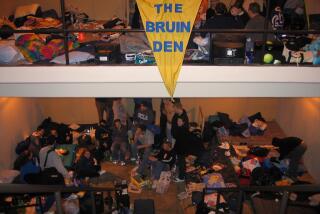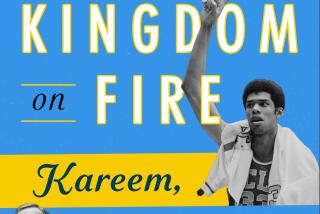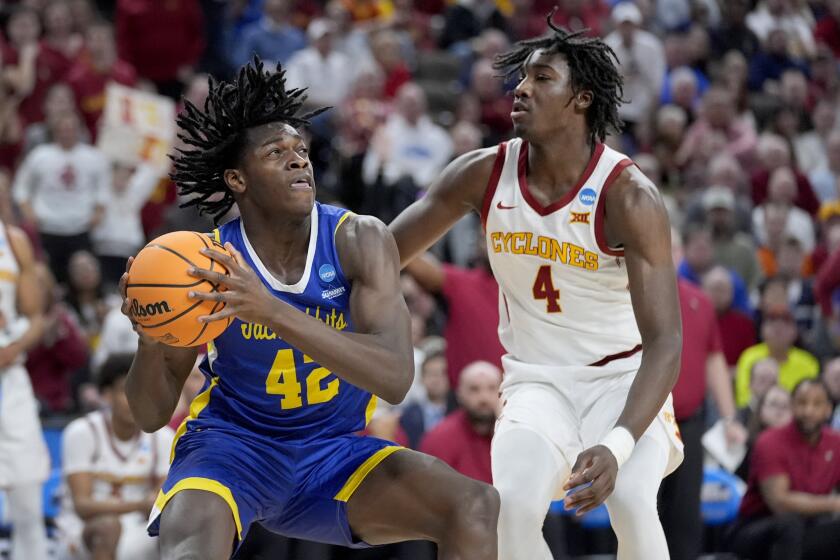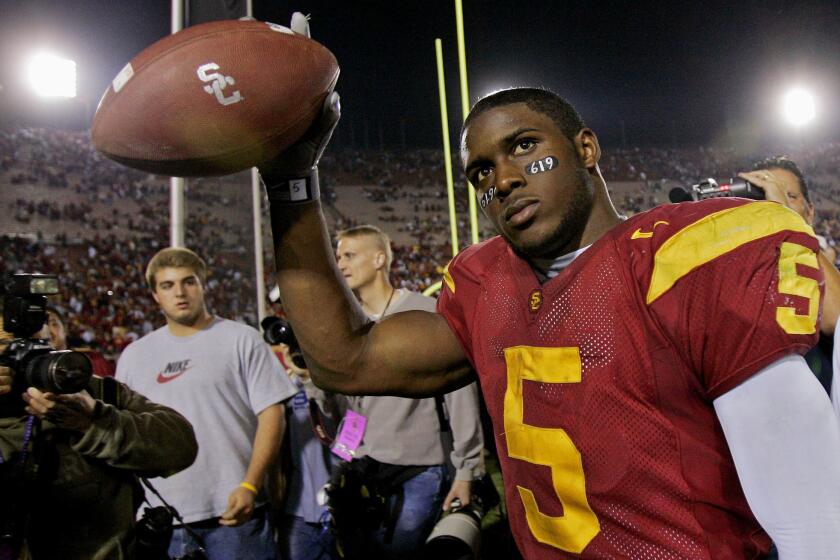Summers with John Wooden
For years, John Wooden ran basketball camps for kids during the Southern California summers. Two Times staffers recall their experiences with the legendary coach.
----
In 1975, I was an 11-year-old aspiring NBA player enrolled in John Wooden’s basketball fundamentals camp at California Lutheran in Thousand Oaks.
At the time, my talents were not too obvious. I was 4-feet-10 and tipped the scales at 74 pounds. According to a player profile card I received at the end of camp, I couldn’t dribble with my left and my “movement without the ball” was graded only as “fair.”
My desire, however, was evaluated as “excellent.”
My dad was a UCLA grad and a huge fan of Bruins basketball. He would let me stay up late with him on school nights to watch the tape-delayed broadcasts of the games. We’d sit on the couch, eating bowls of ice cream as my dad provided his own colorful commentary on the game. He’d also school me on Wooden’s well-known maxims: Be quick, but don’t hurry. Failing to prepare is preparing to fail. Inevitably, I would fall asleep before the game ended.
Those moments instilled in me a love of basketball and reverence for Wooden.
Shortly after Wooden won his 10th NCAA championship and retired, my parents gave me a surprise gift and enrolled me in his weeklong summer basketball camp. It would my first time away from home.
The camp was held in August, and we shared the campus with the Dallas Cowboys, who held their training camp there. I recall collecting autographs of several football players, including Roger Staubach. But the real star in my eyes was Wooden.
I assume the 200 other campers hung on Wooden’s every word as I did. When we first arrived at camp, we were given a pair of Adidas shoes and a “Player’s Notebook.” The 34-page pamphlet contained Wooden’s “Pyramid of Success” chart, some of his favorite poems and detailed instructions on offensive and defensive fundamentals. A section on free throws, for example, contained 10 key rules a player should follow. [Rule No. 8: Do not worry about a missed shot. Your percentage of making the next one increases with every one you miss, providing you do not worry.]
In our initial meeting with Wooden, he gave us the same lecture he famously gave his college players on the proper method to put on socks to avoid blisters. Naturally, the experience — and talent — level of the campers varied greatly. The camp, which sold-out annually, was for boys in third through 11th grades.
Coaches from other college and high schools did most of the intensive work with the campers. We were sorted by age into small teams. Wooden would make the rounds as we practiced offering tips and advice. Twice a day the campers would meet in the gymnasium and Wooden would preach the game’s fundamentals and run us through drills. Occasionally, former UCLA stars were there to demonstrate.
For me, his messages at camp were clear: If you worked hard and were passionate about your pursuits, you could succeed. And, one should lead by example and put the goals of the team above personal achievements.
I went on to play for my high school basketball team. But it was abundantly obvious I was not good enough to play in college. I did, however, cover my school’s team for the campus paper and played intramurals. Dreams of being a basketball player gave way to a desire to become a reporter.
Like many, I found that Wooden’s philosophies carried over to all aspects of life. And like my dad, I try to impart Woodenisms to my two young sons. You didn’t have to have been coached by Wooden to have been one of his disciples.
----
From the time I was a 6-foot-4, 165-pound freshman center in 1968 until I was a 6-foot-4, 175-pound senior shooting guard in 1971, I attended John Wooden’s basketball camp for two weeks every summer at Palisades High School. The camp’s coaches at the time were Gary Cunningham and Denny Crum from the UCLA staff, plus Bud Ware from Taft High, Jerry Marvin from Palisades and, of course, Coach Wooden.
As his players and anyone who attended his camps will tell you, the very first thing we did on the first day of camp was all sit down on the gym floor, take off our shoes and socks and watch as Coach demonstrated how to put them on correctly, so that we wouldn’t get blisters. Every morning he led about 200 kids through warm-ups and drills — he was about 60 then and still extremely quick. In defensive drills, he could stay with almost any kid in camp.
He never swore, and didn’t tolerate it from us. If we continually messed up a drill, he’d holler “Goodness gracious!” or “Sakes alive!” If he got really angry, it’d come out all together: ‘“Goodness gracious sakes alive!”
Before we could break for lunch, everyone had to make a pair of free throws. One day I could not make the second shot to save my life — long after the other kids were outside eating, I was still at the line trying to make two shots in a row — I think it took me 15 or 20 minutes before I got to have lunch, but I had to make that one-plus-one or starve trying.
My freshman and sophomore years at the camp, the best player by far was Greg Lee from Reseda High; he was the City Player of the Year, averaged about 30 points a game — just an amazing athlete. Even though he was one of the taller kids there, he was always playing point guard — later on, of course, we found out why.
One day while we were scrimmaging, Coach Wooden came over and started whispering to Coach Cunningham; it was apparent they were very happy about something, and when Coach Cunningham called us all around later we asked what was up. He said that “a phenomenal 7-foot redhead kid from the San Diego area” had agreed to attend UCLA that fall. Greg Lee ended up lobbing passes toward the rim for Helix High’s Bill Walton many times over the next few years.
More to Read
Get our high school sports newsletter
Prep Rally is devoted to the SoCal high school sports experience, bringing you scores, stories and a behind-the-scenes look at what makes prep sports so popular.
You may occasionally receive promotional content from the Los Angeles Times.






